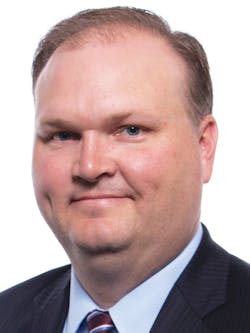Embarking on environmental sustainability
Establishing an environmental sustainability movement, process or project can be an arduous exercise, competing heavily between higher-priority issues and among numerous multitasking executives, clinicians and practitioners.
But it doesn’t have to be such a daunting task so long as aims and goals are outlined, the strategic plan is mapped and the tactical journey to get there is carried out.
“The best strategy to start a sustainability program is to begin with something small but meaningful,” he said. “Opportunities abound within every organization to improve environmental sustainability. The key is to limit the distractions and focus on an initiative where you have a key relationship, span of control, special expertise or some other advantage that will allow for a successful implementation. Success builds credibility, attracts resources and creates momentum for future initiatives.”
“Adopt what is currently on the market,” he urged. “Several manufacturers have invested in innovation to design and make a more environmentally friendly alternative. Work with current distributors and GPOs to remove contractual or financial barriers to convert to these alternatives as soon as they are available. These industry players can help hospitals make immediate changes. In fact, our customers face a difficult hurdle when they want to purchase our products because of contractual penalties. Every day the status quo continues, the pollution and carbon emissions from healthcare remain unchecked. The largest distributors in the market must realize their role in helping to mitigate the millions of tons of plastic pollution and carbon emissions with some pretty basic product selections. And customers are asking for solutions. You will see a whole new generation of healthcare workers that will be pushing hard for these changes to be made on behalf of human and planetary health.”
“What works well for one hospital may not work for a competitor down the street,” she indicated.
Olivier proffered three essential tips for the trek down the right path:
1. Determine your biggest areas of concern within your organization. “The most common areas of a hospital we see customers wanting to address include the OR, laundry service, food service and patient rooms,” she said.
2. Determine the appropriate people for an internal committee. “You will want to create a committee of people who can help champion initiatives and get their colleagues excited,” she continued. “Determining your priority areas first will help guide who may be on the committee. You will want to select people who are impacted by that area of concern. For example, if it is the operating room, consider nurses, doctors, materials coordinators, etc. Anyone who works closely with that unit on a daily basis.”
3. Determine who outside of your organization can help guide your goals and initiatives. “A third-party resource, like a supplier and/or group purchasing organization, may provide consulting services and education that address your specific goals. If the resources are not available inside the organization, consider finding someone who can help quantify and report on your organization’s ongoing initiatives to gauge environmental and financial impact,” she noted.
“When it comes to environmentally sustainable products, the first step is to work with your materials provider to determine custom solutions to meet sustainability goals,” he said. “We work with each client individually to determine the materials solutions that will help meet their business and sustainability goals.”
Beyond that, Trinseo focuses on its own operations “to further infuse sustainability in everything that we do,” he added.
“We started with assessing trends in sustainability, and measuring ourselves against industry peers, while also joining industry groups and/or initiatives that have outlined actionable goals and agendas for reducing waste and becoming more sustainable in our industry,” von Het Hof continued. “With the support of our leadership, we then went to work on creating a Sustainability Council, which brings together a diverse cross-section of leadership from throughout the company that play an important role in our sustainability journey by representing various areas of our business as we set strategy, and also working as an ambassador for our sustainability efforts.
“Working with the Sustainability Council, we produced our first corporate social responsibility report in accordance with the Global Reporting Initiative (GRI) framework, designed to help us evaluate and improve our sustainability efforts in a number of levels, ranging from Environment, Health, & Safety – an area in which we are among the top decile of chemical companies – to environmental compliance, supplier relations, labor and employment policies, corporate governance programs and community involvement,” he said. “This approach has helped us to develop meaningful operational adjustments to become a more sustainable company, and to help increase sustainability around our value chain.”
1. Understand product chemistry to establish baseline standards.
2. Put policy guidelines in place for safer chemical management.
3. Set a goal to purchase safer products and commit to it.
4. Develop and implement a campaign to educate staff.
“Once the team is in place, it should focus first on eradicating chemicals of high concern,” Nguyen emphasized. “This will eliminate known hazards and provide safer alternatives, improve the bottom line by reducing disposal costs/liability, ensure a healthier environment for patients and clinicians and help encourage manufacturers to create safer products.”
“Facilities should properly identify slow-moving inventory items, attempt to return or transfer products for which they have no use, then before excess items expire, monetize any items they cannot use or otherwise find a home for by liquidating them with WestCMR,” he advised.
“Do what you can to support sustainability,” she suggested. “Even small steps like using recyclable lunch room utensils and having recycling bins throughout your company make a difference. While some apparel brands have started to incorporate sustainable elements into [their] fabric production, Barco [Uniforms] has been integrating recycled plastic bottles into its scrub fabric technology since 2006 in spite of the additional cost incurred with the RPET manufacturing process. We believe it’s the right thing to do because sustaining our environment matters to us.”
About the Author
Rick Dana Barlow
Senior Editor
Rick Dana Barlow is Senior Editor for Healthcare Purchasing News, an Endeavor Business Media publication. He can be reached at [email protected].









